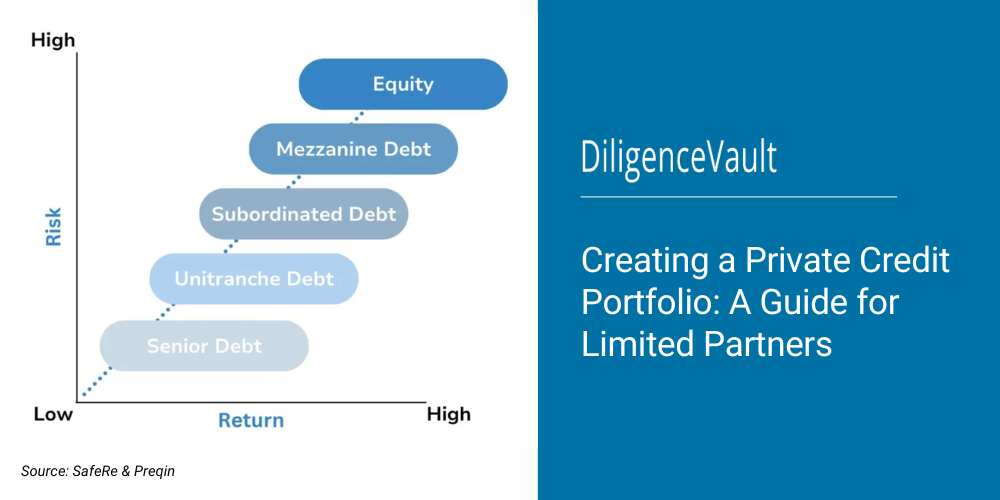Investing in private credit can offer attractive risk-adjusted returns, portfolio diversification, and stable income streams. However, constructing a successful private credit portfolio requires careful planning and consideration. This guide outlines the key steps and considerations for limited partners (LPs) venturing into the world of private credit.
1. Determining the Source of Allocation
Before diving into private credit, it’s essential to decide where the allocation will come from. Typically, private credit allocations are carved out from a broader fixed-income allocation, but they can also come from alternative investments or opportunistic allocations. Consider the overall portfolio strategy and risk tolerance when making this decision.
2. Portfolio Construction Considerations
- Number of Funds: Diversification is key. Aim to invest in a mix of funds to mitigate risks associated with individual managers or strategies. A well-diversified private credit portfolio might include investments in 5-10 funds.
- Risk-Return Expectations: Private credit strategies vary widely in risk and return profiles. Direct lending typically offers lower risk and moderate returns, while opportunistic and distressed strategies can offer higher returns but come with increased risk. Balance your portfolio to match your overall risk-return objectives.
3. Execution Strategy
- Fund of One: This structure allows for a customized portfolio tailored to your specific investment goals and preferences, offering greater control but requiring more significant resources and expertise.
- Fund of Funds: Investing in a fund of funds can provide instant diversification and professional management but often comes with an additional layer of fees.
- Commingled Funds: These are pooled investment funds where multiple investors contribute capital. They offer diversification and professional management but less customization.
4. Investment Horizon
Private credit investments typically have a medium to long-term horizon, ranging from 3 to 7 years. Consider your liquidity needs and the lock-up periods associated with private credit funds before committing.
5. Benchmarking
Selecting the right benchmark is crucial for evaluating performance. Common benchmarks include:
- Fixed Income Indices: Such as the Bloomberg Barclays Aggregate Bond Index, for a traditional comparison.
- Leveraged Loan + Spread: Often used to measure performance relative to leveraged loan markets.
- Cambridge Private Credit Benchmark: Provides a specific benchmark for private credit performance.
- S&P 500: Useful for comparing performance against broader equity markets, though less relevant for pure credit strategies.
6. Private Credit Strategies
- Direct Lending: Loans directly to mid-sized companies, often providing stable income with moderate risk.
- Opportunistic Credit: Investments in distressed or special situations, offering higher returns but with increased risk.
- Specialty Finance: Includes niche lending areas such as consumer credit, small business lending, and asset-backed lending, which can offer unique risk-return profiles.
7. Databases and Consultants
- Databases: Utilize platforms like Preqin, PitchBook, and Refinitiv for market data, fund performance, and manager research.
- Asset Consultants: Collaborate with consultants such as Cambridge Associates, Mercer, or Aon. These consultants provide valuable insights, due diligence, and performance benchmarking to help navigate the complex private credit landscape.
8. Required Resources
Building and managing a private credit portfolio requires a dedicated team with expertise in credit analysis, fund selection, and portfolio management. Ensure you have the necessary infrastructure, including legal, compliance, and operational support, to manage these investments effectively.
9. Pacing of Investments
Pacing your investments is crucial to avoid vintage year concentration risk. Stagger your commitments over several years to spread exposure across different market cycles and economic environments.
10. Other Considerations
- Due Diligence: Conduct thorough due diligence on fund managers, including their track record, strategy, risk management practices, and alignment of interests.
- Regulatory Environment: Stay informed about regulatory changes that could impact private credit markets and investment strategies.
- ESG Considerations: Evaluate how environmental, social, and governance (ESG) factors are integrated into investment decisions, as this can impact long-term performance and risk.
- Market Trends: Stay abreast of trends in private credit, such as shifts in borrower demand, changes in interest rates, and economic cycles, to adapt your strategy accordingly.
Creating a private credit portfolio involves multiple layers of decision-making and strategic planning. By carefully considering allocation sources, portfolio construction, execution strategies, and other key factors, LPs can build a resilient and high-performing private credit portfolio.



